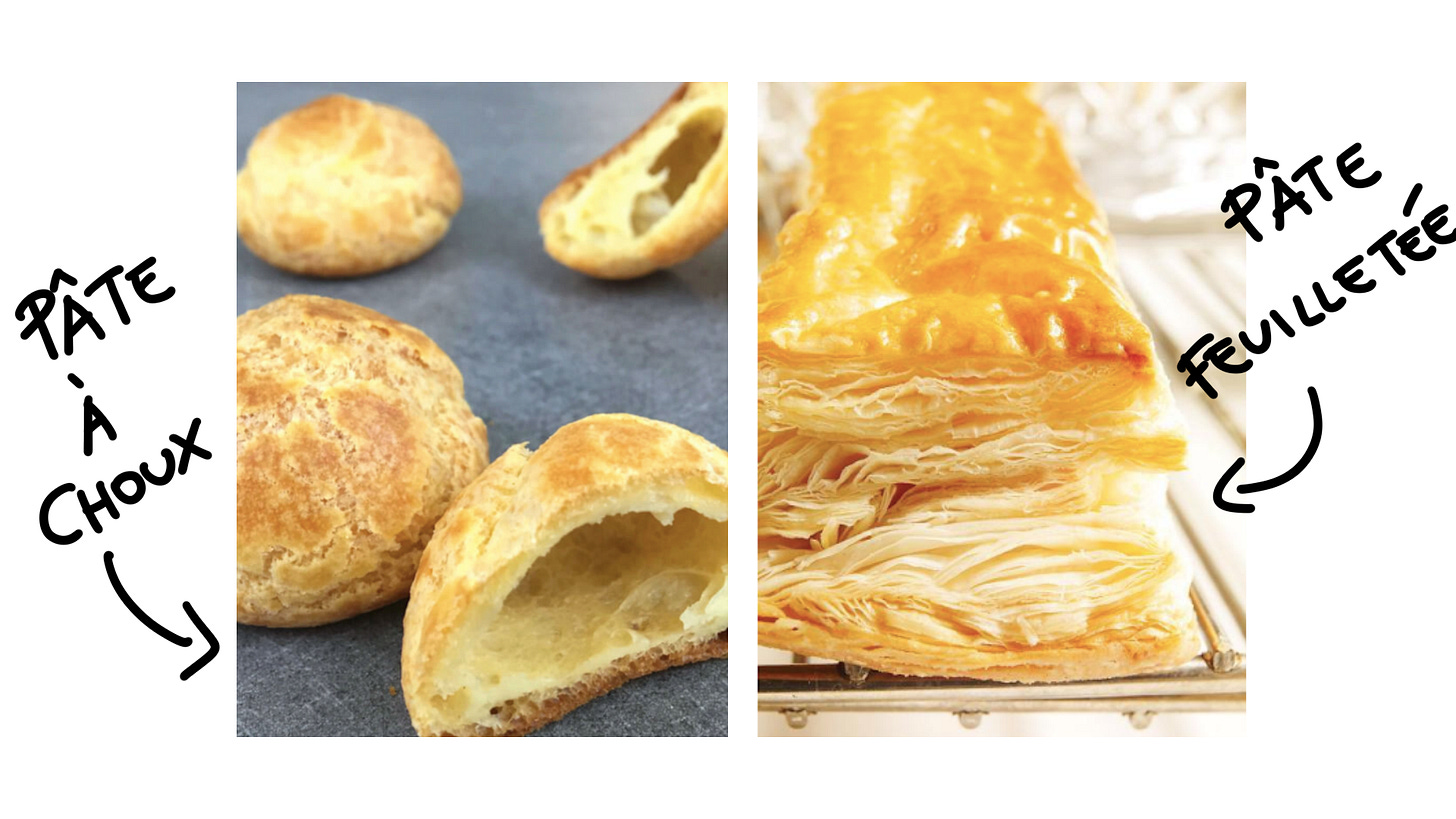Welcome back to the best newsletter on this side of the Mississippi!
If the comfort foods put you down last week for a long nap, wake up! It’s time to shape up to be able to have that nibble of dessert. For the second week in November, Stovetop Hot offers up French Pastries Part 1, the first-ever dessert I mastered in France in Sunday Dinner, and of course the best tidbits in Microwaving those leftovers!
Stovetop Hot: The Sweetest Place in the World.
I cannot tell you how much I was under-prepared to set foot in the city of lights as it pertained to food. Of course, you’ve heard of croissants beforehand, the bread there is wonderful, the cuisine is top-notch, the pastries... Think of the movie Willy Wonka and the Chocolate Factory. As I strolled throughout Paris the few days after my arrival, all I could think about was how lucky I was. It was as if I stepped into another world - as if I had been given a golden ticket.
France didn’t always have the dessert popularity that it has now. It started centuries ago, specifically in the 19th century. During this time, desserts made their way not to be just a course between two other dishes, an entremet, anymore. Chefs were now placing these pastries on their menus, and cookbooks finally had them mentioned. Now, pastries are king and the chefs pâtissiers that make them, rock stars. They are household names and their pâtisseries (shops) are constructed like art galleries. They have created a culture where perfection is not the goal but the standard. Beauty often comes with complexity. There are multiple layers and textures throughout each dessert, and the competition level is insane. Most pâtisseries will feature a rotation of 5-8 different pastries. When you ask a Parisian their top 5 pastries, tastes will differ completely. The classics, mind you, are over 30 in number. Today, I will introduce just a few of the pastries that are on this list, the reason why you should order one, and how you will know that it has the potential to be France-worthy.
Let me share a few terms. First, la pâte à choux. This dough is the base of numerous pastries: it has eggs, milk, butter, and flour in it. Think of a buttermilk biscuit, specifically the top layer. Now, envision that the entire outside of the biscuit is made of this top layer, the inside of the biscuit is hollow, and the general vibe is puffy. When the French people read this comparison, I am sure to be put in jail for crimes against the French culture. Moving on. This pastry is very simple but extremely difficult to consistently make. The reason? There is no added yeast, baking soda, or baking powder in the dough to help it rise in the oven when cooked.
Next, we have la crème pâtissière. I love this stuff! Have you ever had pudding or a creme pie? Crème pâtissière is the base of so many different pastries because you can add purées or chocolate (or both) to it. When you put this crème inside cooked pâte à choux, you essentially have the start of an all-time French staple: with the addition of a glaçage of chocolate or your favorite flavor, you made the mighty éclair!
Lastly, there is la pâte feuilletée. You might know this as puff pastry, it is stacked layers of dough and butter, repeated in this order nearly 1,000 times! The texture is light, airy, crunchy, and always buttery.
Now, let’s stroll down the cobblestone streets together. Follow the smell of fresh bread and look for the huge windows that show off the best pastries in the world. We are first going to stop at the oldest pâtisserie in Paris that dates back to 1730, Stohrer. This is where the tarte au citron reigns supreme. When you combine a crumble tart shell, with candied lemon peels, a thin crème pâtissière of lemon and lime juice, and finally meringue infused with yuzu, you get this creation from Stohrer’s Chef Jeffrey Cagnes. His artistry of éclairs is just as legendary, and a visit to his historical pâtisserie will have you taking a step back in time. If you aren’t in his area for this citrusy craving, here are a few rules to ensure that the tart you may possibly purchase is up to the standard:
First, it needs to look beautiful, nicely colored, and neat. Check the meringue: if it looks wet and gleamy, it means they did it right, incorporating the sugar at the proper temperature. Next, a very bright yellow usually means it has gelatin in it - go for a paler yellow to make sure it is creamier (and vegetarian!).
To transition to a more traditional pastry, we have the delightful Paris-Brest.
This dessert starts with cooked pâte à choux in a circle form to represent a bicycle wheel, in honor of a race from Paris to Brest in 1891. If you slice a chou in half, you’ll see it is filled with hazelnut crème pâtissière and the exquisite sauce praline maison. This sauce is puréed roasted hazelnuts combined with fresh-made caramel. It will turn into a paste, with the addition of a warm chocolate ganache to the mixture. It is luscious. I made a whole jar of it last week and it is already gone.
To finish the Paris-Brest, toasted slivered almonds are put on top with just a little sprinkling of powdered sugar. At Le Meurice, you will find the best version there is. Before Chef Cédric Grolet became the best pastry chef in the world in 2018, he was known for his caramel making. One could say that it lent very well to this pastry. When you buy it, ask if you can buy the praline as well in a big, big (big) jar.
With a slight break before our last pastry, I would like to circle back to Cédric Grolet. His imagination for realistic fruit pastries that he has created is next level, both because of the exquisite desserts that he presents and because of the system that he had put in place: the chefs proceed to construct the pastries right in front of you behind a glass wall, picking through the huge trays of berries for the freshest ones, piping the different creams into the correct form, and drizzling fresh caramel sauce over one. I have never seen such a structure for freshness when it comes to desserts.
For the last pastry of our Pastries round 1, let me introduce the mille-feuille. The name translates into 1,000 leaves and it starts with pâte feuilletée. When you are buying this special dessert, always check the top layer for it to be caramelized. This is a nifty little trick that changes the entire taste. Chef Kevin Lacote has made this classic into a crowd-pleaser. In the spring and summer months, look for the seasonal berries to be incorporated. Outstanding.
I have always had a sweet tooth or three. When I had to complete an internship to be able to receive my diploma from Le Cordon Bleu, I was lucky to be placed at L'étoile du Berger, one of the best bakeries in Paris. In France, they often merge bread and pastries into one boutique: I was able to see the pastry chefs creating works of art from afar, all the while creating all sorts of baguettes and viennoiseries. At the end of one of my shifts, the pastry chefs needed an extra pair of hands. I volunteered. Over that following month, I stepped forward every time there was an opportunity. I mean why not, free education. This constant volunteering was noticed by the owner and not after long, I received my golden ticket to work in Wonka’s factory.
My first day, I remember so clearly. As I walked in with my pressed chef jacket, I was greeted by the head chef. This is how it went:
“Burton, you have now been placed in pastries not by my decision. We do not speak American here, we speak French. We do not cook American, we are French. You will work as a French person does. You will be perfect. When you are asked a question, you respond in French. When I ask you to perform a task, you say oui chef.”
I was happy as a clam. I got my foot in the door and I was ready to climb the hill. I wrote down everything and I learned over my year in the French pastry world, how to be perfect.
Sunday Dinner: Dessert really is the best course.
The first thing that I learned how to perfect was the tarte au citron.
Tidbit: For the crust, you need to make it the day before and set in the fridge for the following day. It is easier to roll. Also, use a lot of flour when rolling and try to work quickly.
Let’s start with the crust:
Fill me up buttercup:
Microwaving those leftovers: Weekly recs for you and yours.
Crack a crème brûlée - It is one of the most oddly satisfying de-stressing things you can do. Finally, it is your one time to play with your food as an adult.
Hello Netflix and Chef’s Table: Pastry - This series documents pastry chefs from all around the world. Who could resist a crack pie? *Disclaimer* There is no actual crack in the pie.
The French Bastards: Talking about rock stars! Their edgy name and punk vibe are proof that they definitely operate on their own schedule. This bakery surfs on the wave of the new French baking scene, with classic products - but with a twist.
If you’d like to enjoy some alternative baking, welcome to the first vegan pâtisserie in France, VG Pâtisserie, which launched back in 2016. They source only organic products, so no chemicals of any sort here. The movement is smart and better for your body.
What about you? Any favorite desserts to make or order? What's that little secret pleasure that satisfies your sweet tooth? Comment below, Pastries Part 2 will be here before you know it!
Thank you for your time in reading this week’s newsletter, and thank you to the best team in the business for making it possible. Get ready for the groovy gravy train coming next week! And remember, you can always hit me up on Instagram!
Au revoir,
Burton












Amazing issue!
Good stuff Chef Burton! I really like pig ears, palmier. Only buy package here, bet you have a scratch recipe. Enjoying your work, can’t wait to truss my turkey 🦃. Thanks for that video